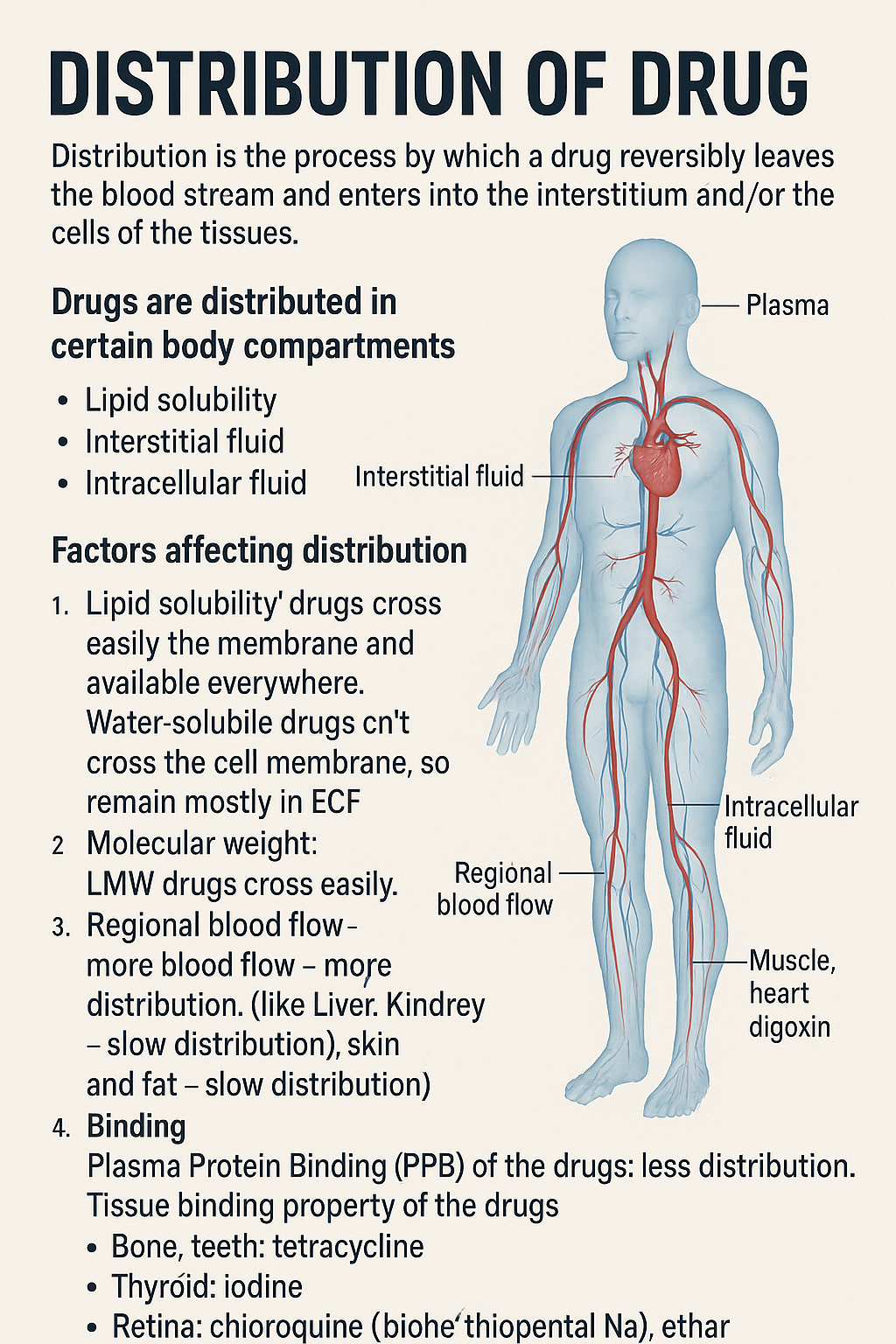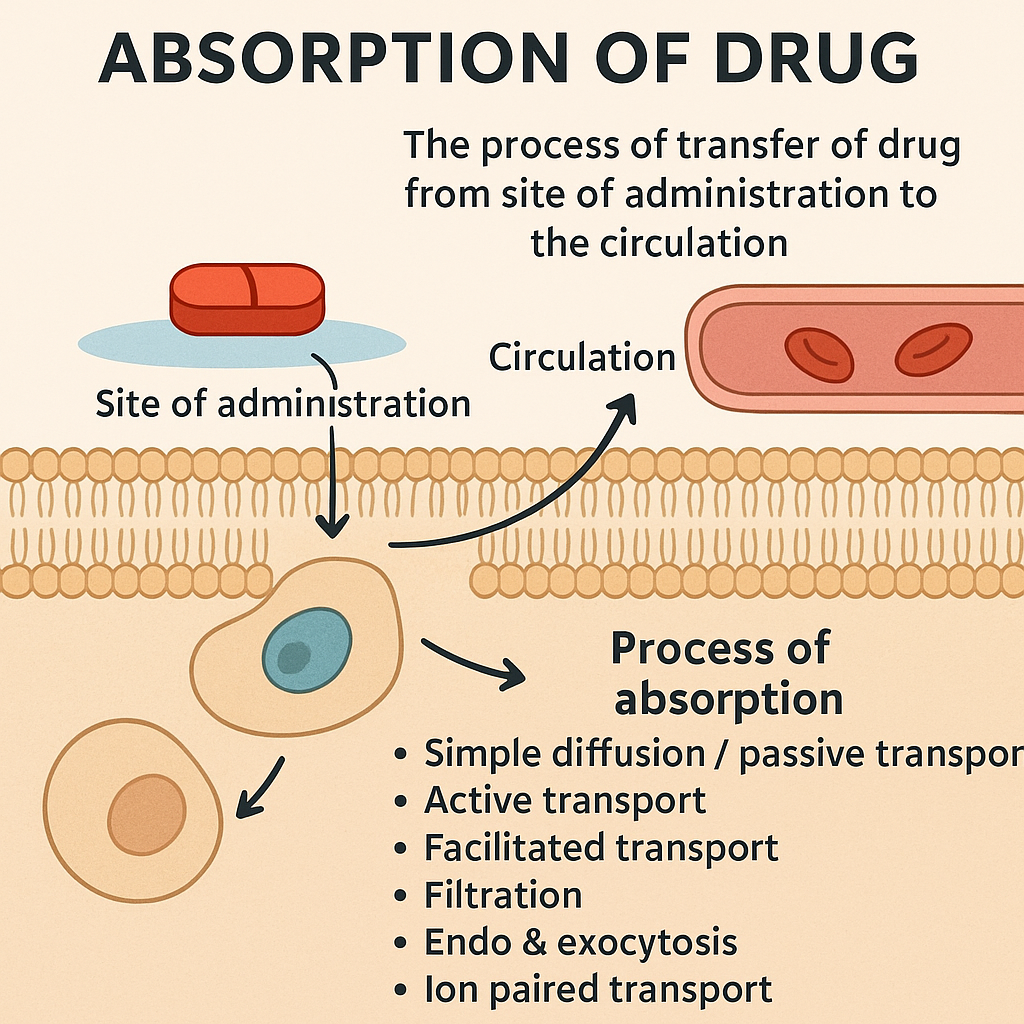Distribution of Drug: How It Makes or Breaks Drug Effectiveness

Distribution of Drug – A Complete Pharmacokinetic Guide
Distribution
Drug distribution is the process by which a drug reversibly leaves the blood stream and enters into the interstitium and /or the cell of the tissues.
Drugs are distributed in certain body compartments
- Plasma
- Interstitial fluid
- Intracellular fluid
Factors affecting distribution
- Lipid solubility: lipid soluble drugs cross easily the membrane and available everywhere.
water soluble can’t cross the cell membrane , so remains in mostly ECF.
- Molecular weight: LMW drugs cross easily. HMW drugs can’t cross.
- Regional blood flow:
more blood flow – more distribution. (like Liver, Kidney, Brain – fast distribution but skin and fat – slow distribution)
- Binding:
- PPB of the drugs – less distribution.
Tissue binding property of the drugs
Tissue Binding
- Many drugs accumulate tissues than plasma.
- Extensive tissue binding delays elimination and increases t1/2 .
- Bone, teeth: tetracycline
- Thyroid : iodine
- Retina : chloroquine
- Adipose tissue : anesthetics (thiopental Na ), ethar
- Muscle , heart : digoxin
Plasma Protein Binding
Reversible binding of some plasma proteins with the drugs in the circulation is called PPB.
Always obeys the laws of Mass action.
Binding with which plasma protein:
- albumin
- β – globulin
- ∝-1 acid glycoprotein
- Lipoprotein
- Generally acidic drug bind with albumin.
- Basic drug generally binds with β – globulin, ∝-1 acid glycoprotein and Lipoprotein.
- Thyroxin and Sex hormones are bind with specific globulins.
Effects of Plasma Proteins on PK and PD of drug
- Drugs circulate either in protein-bound or in free states.
- Protein-bounddrugis pharmacologically inactive…. slow metabolism…. slow excretion.
- Free drugis pharmacologically active…. rapid metabolism…. rapid excretion.
Importance/Significance
I) Disease modifies protein binding of drugs : Patients with hypoalbuminaemia (chronic renal failure, Chronic liver disease ) can experience toxicity .
II) Competition between drugs for protein binding can lead to increased toxicity.
Example:
Warfarin + sulfonamide:
sulfonamide displaces warfarin from
albumin
rapid increase in free warfarin concen.
bleeding.
Drugs with high PP binding
- Warfarin
- Salfonamides
- Tolbutamides
- Quinidine
- Frusemide
- Amitriptyline
Drugs with Low PP binding
- Digoxin
- Morphine
- Amoxicillin
- Ethosuximide
Volume of distribution
It is the amount of fluid in which the administered drug is distributed at a concentration equal to that in plasma is called volume of distribution.
Vd= dose of drug given(total amount of drug)/Concentration of drug in blood

Significance / Importance
1) Refers to the space in the body into which the drug appears to disseminate.
- Vd low …… drug in plasma
- Vd high …… drug in other tissues
2) Vd is needed to calculate Ld (loading dose ) in a clinical setting.
- High Vd …. long t1/2 …. long duration of action.
- Low Vd …. Short t1/2 …. short duration of action.
Drugs with high Vd
- Chloroquine
- Digoxin
- Nortriptylin
- Pethidine
- Diazepam
Drugs with low Vd
- Heparin
- Inulin
- Frusemide
- Gentamicin
- Aspirin
- Amoxicillin
Factors affecting volume of distribution :-
- Pk of drug.
- Degree of plasma protein binding of a drug.
- Lipid water partition coefficient of the drug.
- Affinity for other tissue.
Cellular barriers:
In the brain, the capillary structure is continuous (no slit junctions)
But in liver and spleen it is discontinuous.
To traverse cellular barriers:
Example:
- blood-brain barrier
- placenta
- gastrointestinal mucosa
- renal tubule
REDISTRIBUTION
Termination of drug effect may result from redistribution of the drug from its site of action into other tissues.
Highly lipid-soluble drug (thiopental Na ) reaches brain within seconds after I\V injection…..then to muscle. ……then to fat.
This is known as redistribution of drug.
Significance
- Here , onset of action is rapid, and its termination is also rapid.
Why distribution of drug is not equal in the body?
- Distribution is often uneven, as drugs may bind selectively to plasma proteins or tissue or be
localized within particular organs.
- Drug distribution is not equal due to selective distribution of drugs.
Selective distribution
- Occurs due to special affinity between particular drugs & particular body constituents.
- Some drugs bind to plasma proteins .
- Some drugs accumulate tissues than plasma.
- Bone, teeth: tetracycline
- Thyroid : iodine
- Melanin-containing tissues, retina (chloroquine).
- Adipose tissue : thiopental Na+
Table of Contents
You may also like
Learn more about Drug Absorption and Distribution – NIH resource
An authoritative chapter on the principles of drug movement and distribution from the National Center for Biotechnology Information.
FDA Guide to Clinical Pharmacology
Understand how drugs behave inside the body, including absorption, distribution, metabolism, and excretion, from the U.S. Food & Drug Administration.


